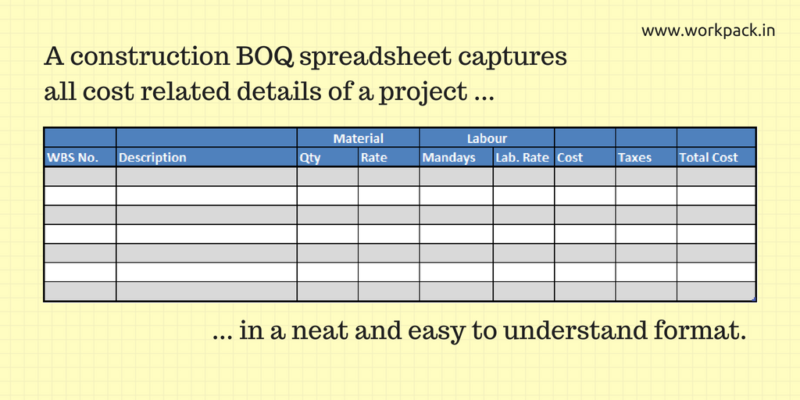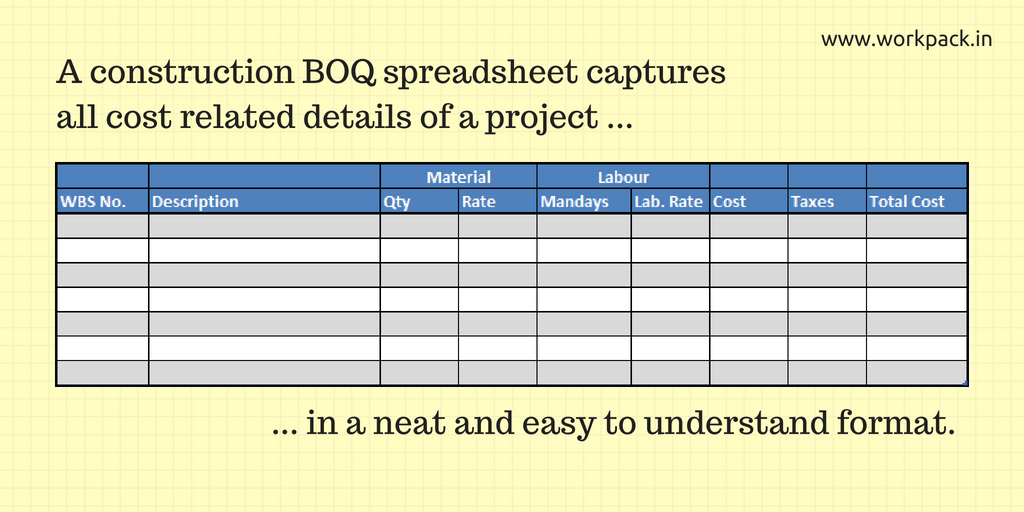Construction projects are normally quite different from one another. They differ in terms of type of construction work, its scale, site conditions etc.
Correspondingly, the scope of work, working conditions and related costs also differ from one construction project to the other.
So how does a construction contractor account for all these differences and estimate the cost of a new project at the bidding stage?
Cost estimation at bidding stage
Whenever a new construction project is to be initiated, project owner (or developer) defines the scope of work for that project and puts it in a ‘Request for Quotation’ (RFQ) document.
This RFQ document is sent to a few selected contractors so that they can submit their quotations for the job.
In their quotations, construction contractors must specify the estimated cost of the whole project. A few contractors normally submit their quotations. One of those contractors is selected to execute the project. The estimated cost submitted by the winning contractor becomes the billable cost for that project.
This quoted cost is one of the most important criteria for award of a project. Lowest cost is normally favored, given than minimum technical requirements are met.
So it is easy to see why the cost estimates are so important.
Then, how to reliably estimate the costs of construction work, considering the fact that each project is so different than the other.
Basis of cost estimation for construction work
Breakdown of scope of work
Cost estimation engineer on the construction contractor’s team normally tackles this problem by first breaking it down to smaller pieces.
Total scope of work of a project is broken down to smaller areas/units. Area wise work is further broken down to smaller activities.
For example, the total scope of work for a new building gets broken down to different floors of the building. Work to be done on each floor is further broken down to smaller tasks like – brickwork, flooring, plumbing etc.
Material and labor requirements
Then costing engineer estimates the costs of material and labor required for each of these small activities – for example, total brickwork for 3rd floor of a new building.
Cost estimation for the smaller activities is considerably easier, as they can be easily quantified in terms of material and labor. Further, the required labor and material quantities multiplied by their respective rates give us the cost of that single activity.
When similar costs of all these small construction activities are summed up, we can arrive at fairly accurate and reliable cost estimate for the whole project.
Bill of Quantities (BOQ)
Bill of Quantities or BOQ is a document that is very widely used to –
- Capture the complete scope of work of a project
- Break it down to smaller activities
- List the material and labor requirements for each activity
- Estimate the costs for each construction activity
Basically it is a neatly organized format, for cost estimation calculations discussed above.

Usually the BOQ for a construction project is captured in a spreadsheet format. Where all the small tasks of a project are listed as different line items. Material and labor requirements for these activities are captured in the same spreadsheet along with their respective costing rates.
Quantities of material / labor multiplied by their costing rates provide the total cost of each activity. Other details like tax codes, tax amount, transport cost etc. can also be added to this same spreadsheet.
This way, BOQ spreadsheet is a very neat format to capture all costing details of a project. It is also very easy to understand and to use.
That is why the BOQ document is invariably used for cost estimation of a construction project at the bidding stage.
Variation in costing rates
Owing to the differences between project conditions, site locations etc. landed material costs and labor rates can vary significantly.
So a costing engineer must account for these differences when preparing a construction project BOQ.
Normally, costing engineers rely on historical project cost data when estimating for a new project. So if they are estimating the cost of a new project to be done in another city. They will first refer to actual costs for a past project from that city – to account for the location related cost variation.
Also, older BOQs of similar types of projects are good reference points to identify the activities to be done for a new project.
Even after a project is completed, its BOQ and actual cost data can come in handy later, when estimating for similar projects in the future.
All things considered, it is easy to see why the BOQ is one of the most important project documents in construction, especially at the bidding stage.


1 Comment
shariq khan
August 14, 2018
Do any MS Office application(except MS Excel) or software used for costing.
second what is job costing sheet?